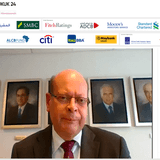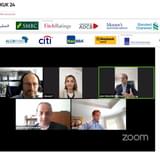Few doubt that Peru has many unfulfilled infrastructure needs. Just a few kilometers outside of Lima, roads can quickly turn into unpaved, narrow paths through the mountains. The nation’s main international airport has only one runway. Upscale houses even in leafy districts of the capital, Lima, can have multiple ownership claims on the land. The list of projects waiting to be undertaken is long, even without taking into account the more recent political scandals involving Brazilian construction companies and corruption that put the brakes on some large infrastructure projects, including a natural gas pipeline to the southern regions.
How to overcome some of these bottlenecks was hotly discussed at this year’s Project Finance and Capital Markets Peru briefing day, organized by GFC Media Group.
As if things weren’t bad enough, widespread flooding and mudslides in March this year destroyed bridges, roads and property in a large swath of the nation. Peru’s Finance Ministry estimates those two events – the corruption scandals and the weather-related damage – will cost the economy 1.5% of growth in 2017 compared to the previous year period. The ministry is forecasting an expansion of 3.0% in gross domestic product this year.
The administration of President Pedro Pablo Kuczynski, in response to the long-standing infrastructure shortfall, will implement a three-year national development plan, the first of its kind in the Andean nation. Mr. Kuczynski, a former prime minister, took office in July, 2016 with promises to help build Peru’s lagging infrastructure. The president knows the financial markets well, being an economist and former World Bank official who worked as an investment banker. He also led in the early 2000s the first sovereign bond placement by Peru in about seven decades.
Although Peru went through a rough patch economically and financially in the 1980s, over the last 25 years or so it has shown remarkable stability in its monetary and fiscal policies. A process of selling off government assets that began in the early 1990s has continued, often adding more modern methods of structuring the deals. The disciplined performance has been noted by the investment community and is reflected in its sovereign debt ratings. All the major ratings agencies award Peru with investment grade status, placing it among the strongest economies in Latin America.
Still, government officials note that Peru has an enormous gap in infrastructure. The Finance Ministry said recently that in 2017-2018 it hopes to award the largest number of projects from its portfolio in the last 15 year period. It also wants the national infrastructure plan to follow best international practices, such as those found in the United Kingdom and Mexico. Private sector economists often note that Peru still needs to carry out a second generation of reforms.
Reforms Need to Happen
Government officials say that going forward what they want is a greater reliance on public sector spending. The government has a multi-pronged strategy planned, including setting up new mechanisms to mitigate conflicts and to help reach agreements on projects. Heavily reliant on exploiting natural resources as a motor of economic growth, Peru has seen its reputation as an investor-friendly nation weakened by a long series of conflicts in the mining and petroleum sectors. The new government hopes to change that negative perception. Cabinet ministers say that investments have to be sustainable not only financially but also in a social sense.
The Finance Ministry forecasts an expansion in GDP of 4.5% next year, driven in part by increased public sector spending on things like rebuilding from the massive flooding, constructing facilities for the upcoming Panamerican Games, the carrying out of major projects such as the Line 2 of the Lima Metro, and work on some large-scale water projects. The Ministry also sees the weakness caused by the heavier-than-normal rains and corruption being compensated for by improved natural resource prices, increased capital inflows and better growth among Peru’s main trading partners. The rains and flooding earlier this year washed out an estimated 264 bridges, destroyed 2,400 kilometers of highway, and damaged an estimated 37,600 houses.
There are more deep seated, long-running problems though. Peru for example suffers from high costs for logistical support, especially in the regions. One high-level government official notes that delivering coffee from the Cusco region to port can make up half of the cost of production, while in Colombia a similar figure would be 14%. ProInversion, the government agency that has been tasked recently with more heavily promoting investment, aims to unlock a backlog of projects that have been stalled for years.
A wide range of observers say that the government needs clearer policy guidelines for technical and administrative issues, though. It appears to be listening. ProInversion, for example, has changed its board of directors to include three independent members, instead of purely cabinet ministers, aiming to make the board more results oriented.
Among the projects in the pipeline are ones to use rivers for greater transport of goods and to provide increased broad band coverage in the telecommunications sector for various regions. The government is also looking at constructing a train system that would run from Barranca, north of Lima, to Ica, south of the capital, which could be cost more than US$5bn. The Finance Ministry expects overall investments in infrastructure to expand by 25% in 2018 and converge to a level of 2.4% of gross domestic product by 2021, a historic maximum, it says.
The government has published regulations that it hopes will strengthen investment in a mechanism that allows the private sector to carry out works programs in exchange for tax forgiveness. It is also working to strengthen APPs, aimed at speeding infrastructure projects, especially those currently underway.
Possible Solutions
Private sector experts note that the deficiency in infrastructure in Peru remains large, with the main shortfalls coming in the transportation sector, followed by energy and telecommunications. One key goal is to generate confidence to attract investments.
There are a number of changes that would help, experts say. One would be to privatize projects with the use of standardized contracts. There is also the need to ensure clear ownership of lands before they are expropriated as well as easing the issuing of required permits to advance projects.
Ownership of land is complicated in Peru, where various agencies and bodies through the years have issued rights for different owners of properties. One example is that even only 30% of government properties are properly registered. That makes expropriation for infrastructure projects all that much more difficult.
Representatives of the private sector agreed that the process of seeing who the rightful owner of a plot of land is, can take years in Peru. They note that in many cases ownership of land is unclear. The big problem is not with management, but rather who the real owner is, observers say, and correcting this will mean going to the root of the problem, so the lack of clarity doesn’t continue; doing so will help in land transfers and advancement of projects.
Government officials add that there is also the need to have better contracts that will clearly lay out the legal framework for investments, with standardized documents. They also point to the need for more well-developed investment plans, and to the positive effects that flow from having financial instruments that mitigate risks.
Debt rating agencies also stress the importance of having a clear legal framework in order to attract investors. They say the main concern is the rule of law. A contract can contain all sort of safeguards, but if the risk materializes, the question is whether the protection will actually be effective, the rating agencies note. What investors want is make the financial part of any deal more predictable.
Government officials say that it can take over two years to free up land through expropriation, leading to delays in projects. The aim is be able to reduce this by 80%.
The government has also started a mechanism, known as APIP, to simplify access to land for ProInversion’s priority projects, and which is expected to mainly benefit a portfolio of APP projects worth about US$15bn that have already been awarded, but where there have been problems in accessing territory, the Finance Ministry says.
It adds that the portfolio of APPs includes 33 projects worth US$7.05bn for the 2017-2018 period, among them a highway project in the Andes Mountains worth US548mn, and work on the railway that joins the central cities of Huancayo and Huancavelica, worth US$241mn. The finance ministry wants the number of public and private sector joint ventures to double from the current number within ten years. The government is looking into creating an infrastructure fund to help cover risks in the private sector.
Corruption Aftershocks
The recent corruption scandals hit hard at the construction sector in Peru, dragging in government officials and those in the private sector alike. One high-profile victim was the Gasoducto Sur Peruano, or Southern Gas Pipeline, a 1,134-kilometer natural gas pipeline that was partially built, but stalled when a scandal involving under-the-table financing hit Brazil’s construction giant, Odebrecht. Odebrecht Ingeneria & Construction International was leading the work on the Gasoducto Sur Peruano, which had an estimated cost of some US$7.33bn. The Peruvian government is planning to reissue the concession for the project within a year.
The fallout from the widening corruption scandal has caused investors to think twice before putting any money to work.
The private pension funds in Peru, which have become an important source of project financing, note they have to as a matter of course carry out deep due diligence, given the high levels of corruption. One overriding concern is to avoid reputation risk.
The concerns about corruption linger on the 25 regional governments in Peru, where many political leaders have been hit in recent years by allegations of wrongdoings that in some cases have led to criminal charges. Government funding tied to natural resource extraction often flows into the regional governments with little oversight. Institutional investors have expressed disappointment with the regional governments, especially in terms of improper and opaque practices. High levels of corruption at the regional level have undermined confidence in investing at there, private pension fund executives note.
Government officials, for their part, say that having anti-corruption clauses in infrastructure contracts will become commonplace, but add that they didn’t want to overdo things and put a brake on companies wanting to participate in projects.
Meanwhile investors and financial sector experts continue to look for financially viable projects with stable revenues. They note that the market for infrastructure funding is increasingly competitive, with the landscape becoming very crowded.
They add that development banks and multilateral lenders may be playing a role that is crowding out other lenders, by being aggressive in long-term financing that makes it difficult for private sector lenders to compete. While development banks can play a role in bridging gaps, they need to be cost effective and avoid crowding out other lenders, private sector lenders say. That means showing flexibility and adapting to each specific project.
Peru’s government meanwhile plans to go to capital markets with new bonds to continue work on the upgrade of Petro-Peru’s Talara refinery in northern Peru. The modernization of the state-owned oil company has long been on the drawing board, and estimated costs have risen to some US$5.4bn
The Kuczynski administration has also been taking other measures to boost investments, including replacing a much-criticized system of investment approval, known as the SNIP, with a new system known as Invierte.pe. The administration has also started to clean up the portfolio of the second-tier government lending bank, Cofide. Officials at the development bank say they are ready to continue to invest in projects, but not as sole lenders.
Private sector bankers meanwhile remain broadly optimistic about Peru’s investment climate. They note that when the Kuczynski administration took office in July, 2016, there was a lot of enthusiasm, but the development of new projects has been slower than expected. Investment bankers signal that while the administration is clearly on track and will get the themes right, they are looking for a bit more speed.
Even following the torrential rains and flooding in March that put huge strain on the whole system, investors are still hopeful and remain increasingly optimistic for 2018. They add that a key point now is for the government to be able to deliver, whether that be with multiple small projects or one big one. At this point it is all about execution.





